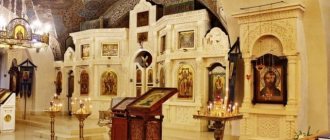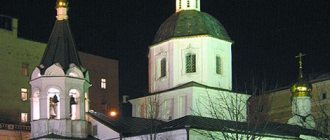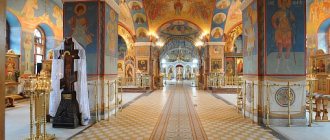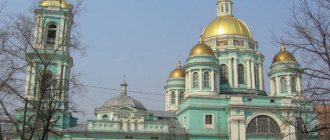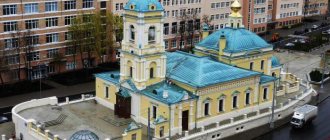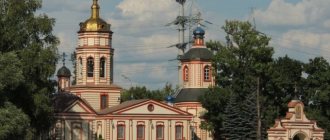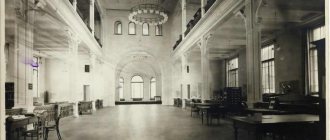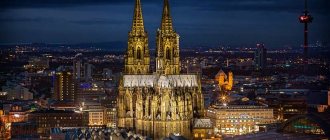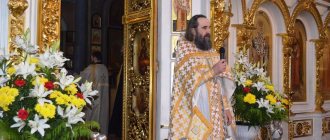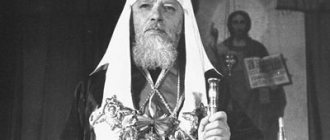The first mention of the Church of the Small Ascension dates back to 1584. The path to Veliky Novgorod then lay at this place. Obviously, the temple became the center of the Novgorod settlement located here.
In 1629 the church burned down. Later it was rebuilt in stone. The blessing for construction was received in 1634.
In 1737, there was a fire in the Church of the Ascension of the Lord, and it was restored only 2 years later. At the same time, the northern aisle appeared in the name of John the Baptist.
Ascension of the Lord (“Little Ascension”) on Bolshaya Nikitskaya, temple
Central Deanery
September 13, 2018
Parish of the Church of the Ascension of the Lord on Bolshaya Nikitskaya Street. (Little Ascension).
Address: 125009 Moscow, Bolshaya Nikitskaya st., 18/2, El . mail: Church website: www.mvoznesenie.ru Phone/fax: / (495) 629-82-53
HISTORICAL REFERENCE
The parish of the Church of the Ascension of the Lord has been known since 1548.
The modern building of the three-altar church was built in 1634. Architect unknown.
The main altar is consecrated in honor of the Ascension of the Lord, the side chapels are dedicated to the righteous Procopius and John of Ustyug and the Beheading of the Prophet, Forerunner and Baptist of the Lord John.
During the years of persecution, the parish was deregistered, and the church was closed for worship and transferred to the national economy in 1937.
In 1991, the parish was revived and received legal registration; the former church building was transferred to it.
On June 3, 1992, on the Feast of the Ascension of the Lord, His Holiness Patriarch Alexy II consecrated the main chapel of the temple.
SACRED TEMPLE
Icons of the Blessed Princes Peter and Fevronia of Murom, St. Theophan the Recluse, Blessed Prince Roman of Uglich with relics. Reliquaries with the relics of the Kiev-Pechersk saints and Optina elders.
WORSHIP
On Saturdays and Sundays, as well as on the days of the twelve and great holidays - The Divine Liturgy begins on Saturday - at 8.00, Sunday - at 9.00, the All-Night Vigil the day before - at 17.00. On Sundays, at 5 p.m., except for the days of Great Lent and the after-feast of the Twelve Feasts, a prayer service with an akathist is served at the venerated icon with a particle of the relics of the Blessed Virgin Mary. book Peter and Fevronia, Murom miracle workers. On days of especially revered saints and icons of the Mother of God - Matins and Divine Liturgy at 8.00.
CLERGY
Archpriest Alexey Damianovich KRUGLIK Born May 24, 1970. Education: Moscow Polytechnic of Communications, Moscow Theological Academy. Candidate of Theology. On November 19, 1995, he was ordained to the rank of deacon. On September 13, 1997, he was ordained to the priesthood. On October 15, 2014, he was appointed acting rector of the temple
Archpriest Alexey Vitalievich DAVIDENKO. Born December 12, 1974. Education: Moscow Aviation Technological Institute, Moscow Theological Academy. On June 13, 2002, he was ordained to the rank of deacon. On December 2, 2003, he was ordained to the priesthood.
Priest Alexander Valentinovich BOVANENKO Born February 26, 1989 Education: Sretensky Theological Seminary (2008-2013) September 27, 2012 ordained to the rank of deacon. On November 20, 2013, he was ordained to the priesthood. On December 18, 2015, he was appointed full-time priest of the temple.
DRIVING DIRECTIONS
Directions to the station metro station "Arbatskaya", "Library named after. Lenin", "Okhotny Ryad".
The church parish operates a children's Sunday school and a Sunday school for adults. On Sundays, after a prayer service with an akathist at the icon of the Blessed Virgin Mary. right Peter and Fevronia of Murom, youth meetings are held in the parish house. There is a youth activist group that carries out its activities in various directions: organizing holidays, helping with the needs of the parish, social and prison service, pilgrimage trips, preparing gifts, educational work, etc.
Abbots
- Paul (mentioned 1666)
- Jacob Joseph (mentioned 1675)
- Stephen (mentioned 1679)
- Vasily Ivanov (mentioned 1764)
- Ioann Vasiliev (mentioned 1771)
- Afanasy Osipov (mentioned 1785)
- Ioann Vinogradov (1830 - 1872)
- Gabriel Sretensky (1873 - March 25, 1890)
- Sergiy Vinogradov (1890 - 1898)
- Kapiton Yastrebov (September 5, 1899 - ?)
- Alexy Gorsky (1899 - 1911)
- Nikolai Delectorsky (1913 - 1919)
- Alexander Poroikov (mentioned 1924)
- Dimitry Delectorsky (? - 1937)
- Pavel Levashev (1937- December 10, 1937)
- Gennady Ogryzkov (August 9, 1991 - April 7, 1997)
- Vasily Stroganov (December 14, 1998 - October 12, 2014)
- Alexy Kruglik (since October 15, 2014) acting rector
From 1937 to 1991 the temple was closed
Temple in honor of the accession of the last Rurikovich
The Small Ascension Church on Bolshaya Nikitskaya appeared in 1584. The reason for its construction was the accession to the royal throne of the last Rurikovich - Tsar Fyodor Ioannovich. It was made of wood and was located in the center of a settlement inhabited by people from Novgorod and Ustyug, who had been resettled here during the previous reign.
In 1634, the wooden building was dismantled and a stone one was erected in its place, which has survived to this day, although it has undergone numerous reconstructions. They were caused mainly by the need to restore the temple after fires that occurred repeatedly in those years.
Church of the Ascension in Kolomenskoye
Church of the Ascension in Kolomenskoye.
Photo: mkrf.ru The Church of the Ascension in Kolomenskoye is one of the most famous Moscow attractions and is included in the UNESCO World Heritage List. It was built in the 1530s by the Italian architect Pyotr Francis Anibale, who in Russia was called Pyotr Fryazin or Petrok Maly.
The Church of the Ascension in Kolomenskoye became the first stone tented church in the history of Russian architecture: earlier churches were traditionally crowned with domes. The 62-meter tower, surrounded by a two-tier gallery, was built of white stone. The facade was decorated with flat pilasters and Gothic vimpergs - pointed ends of window openings. It is unknown what the inside of the temple looked like in the 16th century: its original decoration has not been preserved. Today the church is an object of the Kolomna Museum-Reserve.
Years of hard times
When the atheistic government came to power, the temple continued to function for some time, but at the end of the twenties, the bells were removed from it and sent to be melted down, and in the thirties it was completely closed. At the same time, the crosses were removed from it, and the internal premises were converted to be used for household needs. In 1980, the former Small Ascension Church on Bolshaya Nikitskaya was transferred to the disposal of Glavmosstroy, and one of its branches was located there. This continued until the onset of perestroika.
Return to spiritual roots
In 1992, when a large-scale campaign was underway in the country to return the church to its former property, the Church of the Ascension on Bolshaya Nikitskaya again became the property of parishioners. Before resuming worship services there, it was necessary to restore the external appearance of the building and restore the interior to proper condition. Communities of other Moscow churches helped in solving all the problems that arose in connection with this, providing free material and moral support during its restoration.
On June 3, 1992, the Church of the Ascension of the Lord (Little Ascension) was consecrated. The church had not yet been completely restored, and traces of the former hard times appeared everywhere, but everyone present was pleased to realize that the long-awaited turn to that spiritual beginning and those roots that are the basis of all human life had finally arrived.
Today the temple is one of the most famous and significant religious centers in the capital. In addition to regular services, it conducts extensive educational work with children and their parents. Preparation is also carried out for those who wish to receive holy baptism. They have a library and a wide range of books available in the church shop.
Witness of antiquity
Today, on this longest street in the capital’s center, the temple is the oldest building. Once upon a time, primacy belonged to the Nikitsky Monastery, which was located at its beginning, founded by the grandfather of the first tsar from the Romanov family - boyar Nikita Romanovich, but he was not destined to survive the Soviet hard times.
We often hear the question of what Little Ascension is and where such an unusual name came from. The fact is that in 1848, the construction of another, larger temple, also consecrated in honor of the Ascension of Christ, was completed in Moscow. To make it clear in conversation which of them we are talking about, the old one was called the Small Ascension, and the new one - the Greater Ascension.
The holiday established in honor of the Ascension of the Lord is celebrated on the first Thursday after five weeks after Easter. According to existing belief, this is the last day when sinners who are in hell are given the opportunity to communicate with the righteous who have acquired eternal life and are in heaven.
Russian Orthodox ChurchFinancial and economic management
Object of cultural heritage of federal significance “Church “Little Ascension”, end of the 16th century. - beginning of the 17th century."
Address: Moscow, Bolshaya Nikitskaya street, 18
Rector: Archpriest Alexy Kruglik
Contractor: Pirit-99 LLC (2018-2016)
Technical supervision: NP “Unified Customer Service of the Moscow Patriarchate” of the Russian Orthodox Church (2018-2016)
Author's supervision: StroyIndustriyaGroup LLC (2018-2016)
Temple website: mvoznesenie.ru
RESTORATION
In 2021, as part of the Program for Providing Subsidies from the Moscow City Budget, all restoration work was completed at this site.
In 2021 : repairs and restoration of the roof of the bell tower and apse of the temple, installation of a drainage system, and restoration of stone floors were carried out.
In 2021, work on the repair and restoration of the roof and the completion of the temple was completed, reconstruction of window fillings and metal grilles, repair work in the interior of the temple, installation of a blind area and drainage system were carried out.
In 2021 : repair and restoration of the roof, under-roof cornice; cut-off waterproofing device; restoration of the white stone plinth; installation of a drainage system.
Story
Since the 1830s, the name of the temple “Little Ascension” has become widespread among the people, in contrast to the “Great Ascension” - the newer Church of the Ascension outside the Nikitsky Gate (1827-1848).
The first mention of a wooden church dates back to 1584. In 1629 the building was destroyed by fire. The stone temple was erected in 1634. In the 1680s it was rebuilt; the southern chapel of Saints Procopius and John of Ustyug was added to it.
In 1737 the building was damaged by fire and was restored in 1739. During this reconstruction, a northern aisle was added to it in the name of the Beheading of John the Baptist. In 1764, the temple was built with an octagonal baroque drum topped with a single dome.
At the beginning of the 19th century, the southern aisle was enlarged, an arched gallery was built adjacent to the northern aisle, and a warm porch was built. In 1831, the temple was decorated with a new iconostasis. In 1876, the church was rebuilt according to the design of the architect A. A. Martynov. In 1902, restoration work was carried out in the temple.
After the 1917 revolution, the temple continued to operate for some time. In 1929, the bells were knocked off, which were sent for melting, and in 1937 they were finally closed. At the end of the 1930s, the crosses were knocked down and the interior was refurbished. In 1980, the building housed one of the departments of Glavmosstroy.
In 1992, the temple was returned to the Russian Orthodox Church . The work on its restoration was carried out by the parish community of the Church of the Resurrection of the Word on the Assumption Vrazhek. On the Feast of the Ascension of the Lord, June 3, 1992, the main altar was consecrated. The artists Irina Starzhenetskaya and Ivan Glazunov worked on the paintings. The iconostases were made by icon painter Sergei Fedorov.
Read the detailed chronicle of the temple on the website: mvoznesenie.ru
AllLittle Ascension
Some characteristic features of the temple
The Church of the Ascension of the Lord (Little Ascension) differed from other Moscow churches primarily in the volume-spatial design of the building, oriented along the south-north axis, and its unique decorative design. Significant work was carried out in it at the beginning of the 19th century. During this period, the size of the southern aisle was increased, and a covered gallery was installed on the northern façade. Somewhat later, a two-tier bell tower was erected, ending with a tent.
Very remarkable are the bas-reliefs decorating the façade of the building and the wall facing Voznesensky Lane. One of them depicts Blessed Procopius of Ustyug, who became famous in the 13th century for his prophecies. His prayers are credited with saving Ustyug from a stone hail. It is curious that on the bas-relief he is depicted with pokers in his hands. According to legend, Procopius carried them around the city, and if he held them with the ends up, it meant that a rich harvest and a well-fed life awaited everyone ahead, and if they were held down, there would be hunger.
Church of the Ascension on Pea Field
Church of the Ascension on the Pea Field. Photo: Alexey Gusev / photobank “Lori”
The first Ascension Church on this site appeared under the founder of the Romanov dynasty, Mikhail Fedorovich. In the second half of the 18th century, it was rebuilt by order of the favorite of Empress Elizabeth Petrovna, Alexei Razumovsky. Researchers believe that he entrusted the design of the new temple to Matvey Kazakov.
Among the famous parishioners of the church are actor Pavel Mochalov and the Pushkin family. Alexander Pushkin's brother Mikhail, who died in infancy, was baptized here. During Soviet times, the temple was closed, and the building was given over to the needs of first the Aerodynamic Club, and then a printing house. Today the temple is a center of veneration for Emperor Nicholas II; here is the icon of the Tsar-Passion-Bearer.
